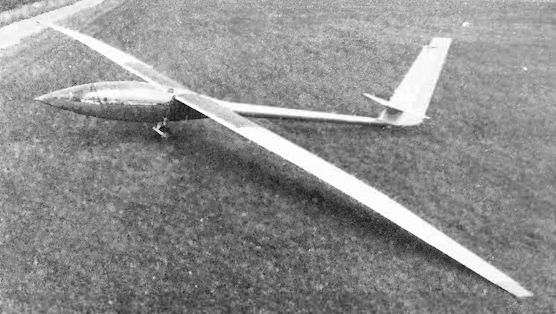
Описание
Страна : Германия
Год : 1972
Планер
Единственный экземпляр
Two-seat high-performance sailplane
M.Hardy. Gliders & Sailplanes of the world
Akaflieg Braunschweig SB-10 Schirokko
The SB-10 Schirokko is an attempt to create a tandem two-seater sailplane of exceptional performance and aerodynamic refinement, and the choice of a high aspect ratio (36.6) wing of 29m (95ft 1 3/4) span - as big a span as a DC-3 airliner - has enabled a best glide ratio of 53:1 and a minimum sinking speed of only 1.3ft/sec to be achieved. Design of the SB-10 began in 1969 and it first flew in prototype form on 22 July 1972; it can also be flown with a wing of 26m (85ft 3 3/4 in) span instead of the 29m one. The wing structure is in five parts: the centre section is of plywood, balsa wood and carbon-fibre, while the outer wing panels and air brakes, as well as the wing tips, are the same as those of the SB-9 Nimbus, but of balsa wood and glassfibre construction with foam filling. Foam-filled carbon-fibre is used for the camber-changing flaps, which can be drooped in conjunction with ailerons; there are three of the latter each side on the 29m wing. The pod-and-boom type fuselage has a finely streamlined forward part, housing the pilots, tapering to a thin boom carrying the tail, and is a steel tube frame covered with a balsa/glassfibre sandwich shell and with light alloy at the rear. The tail unit is also of balsa/glassfibre sandwich construction and has a fixed incidence tailplane mounted low. The landing gear consists of an air-assisted retractable monowheel with a hydraulic brake, and a tailskid. The landing gear, air brakes and rudder controls were later modified, and several other changes made, and in this form the SB-10 set up a German distance record of 577 miles on 16 April 1974.
Data: SB-10
Span: 95 ft 1 3/4 in
Length: 33 ft 11 3/4 in
Wing area: 247.1 sqft
Aspect ratio: 36.3
Empty weight: 1,272 lb
Max weight: 1,978 lb
Max speed: 12 4mph
Min sinking speed: 1.3 ft/sec at 47 mph
Best glide ratio: 53:1 at 56 mph
Akaflieg Braunschweig SB-11 Antares
The SB-11 Antares is a single-seat high performance research sailplane categorised in the FAI Unlimited Standard Class and intended to test a new variable-geometry flap system and to evaluate the use of carbon-fibre reinforced epoxy resin as a constructional material for all parts of a glider. Design work on the SB-11 started in the spring of 1974 and construction of the sole prototype began in April 1976; this made its first flight in May 1978. The SB-11 made its international debut at the 1978 World Championships at Chateauroux, France, when it was flown into first place in the 15m class by Helmut Reichmann, and in November that year it was named Antares. The constant-thickness Fowler flap system is designed to achieve a high average cross-country speed without the operational and technical difficulties of a telescopic wing, as tried on the Akaflieg Stuttgart FS-29, a high aspect ratio giving a very long span wing or a slotless Fowler flap-type wing. To retain conventional sailplane handling characteristics a constant thickness Fowler flap was devised that avoided friction between wing and flap and the need for a flexible lip at the lower surface of the wing. A special Wortmann wing section was evolved for the SB-11 and this was flight-tested mounted on the nose of a DFS Kranich 3 sailplane; the results were sufficiently encouraging to believe that the SB-11, with flaps extended, could outclimb any other Standard Class sailplane and, with flaps in, it would perform as well as a conventional Standard Class type. The cantilever shoulder wing is of 15m (49ft 2 1/2 in) span and has an aspect ratio of 21.3 with flaps in or 17 with flaps out; in the former condition the best glide ratio is 41:1. There is a single carbon-fibre spar with roving spar flanges; the outer shell is a carbon-fibre/plastics foam sandwich. Each wing trailing edge is made up entirely of a 25% chord slotless Fowler flap inboard and outboard a 'flaperon' of 22% chord when in and 17% when extended; both flaps and 'flaperons' are of carbon-fibre/plastic foam sandwich construction. They are supplemented by Schempp-Hirth air brakes on the upper surfaces of carbon-fibre/balsa wood sandwich construction, and wing tanks provide for up to 100kg (220lb) of jettisonable water ballast. The fuselage is a carbon-fibre monocoque and the cantilever T-tail, which as an all-moving tailplane with spring trim, is a carbon-fibre/plastic foam sandwich except for the rudder, which is a glassfibre/plastic foam sandwich. There is a retractable unsprung monowheel with an internal drum brake, and a rubber-spring tailskid.
Data: SB-11
Span: 49 ft 2 1/2 in
Length: 24 ft 3 1/4 in
Height: 4 ft 6 1/4 in
Wing area: 113.7 sq ft (flaps in)
142.1 sq ft (flaps out)
Aspect ratio: 21.3 (flaps in)
17.0 (flaps out)
Empty weight: 573 lb
Max weight: 1,036 lb
Max speed: 155 mph (flaps in; smooth air)
Max aero-tow speed: 112 mph (flaps in)
Min sinking speed: 2.03 ft/sec at 50 mph (flaps in)
Best glide ratio: 41:1 at 64.5 mph (flaps in)
36.1 at 53 mph (flaps out)
- M.Hardy. Gliders & Sailplanes of the world
Фотографии
-
Jane's All the World Aircraft 1974 / 03 - Sailplanes
Akaflieg Braunschweig SB-10 Schirokko two-seat high-performance sailplane
-
GL 1982- / M.Hardy - Gliders and Sailplanes /Gliders & Sailplanes of the world/ (1)
Akaflieg Braunschweig SB-10 Schirokko.
- Фотографии

